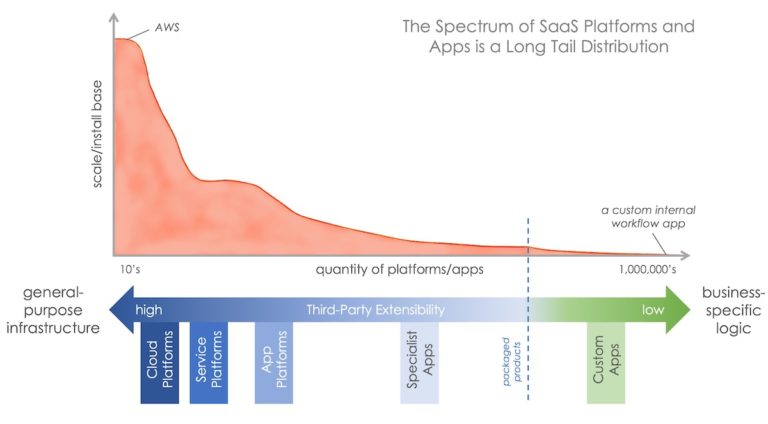Having been a keen observer, investor, and engaged in martech over the years, it feels like analyzing the financial markets. When you look at the complex, interconnected and dynamic nature, the digital engagement ebbs and flows in the martech space, one might wonder – does the martech world need 8000 products?
And if you heard the recent episode of The ABM Conversations Podcast, Scott Brinker said that he expects to see more software in the coming years.
Why so many martech companies?
After tracking 8,000-10,000 martech companies and startups, I’ve seen that the heart of nearly every martech creation and acquisition has been to achieve better experience and higher returns.
Better Experiences + Greater Returns
While not unique, the martech industry, and it’s associated disciplines have served as a lens into the business challenges and opportunities engaging with the digital and connected customer.
So why are there so many products or martech companies? Every year, upon the release of the martech landscape, two things happen:
- A set of people start talking about consolidation
- Another bunch of companies talks about why you need best-of-breed products which also integrates into platforms and ecosystems
But, in practicality, the long tail of software categories are going to expand and contract continuously. Here’s a great resource to read about the platform dynamics driving martech app expansion and consolidation.


Three distinct areas that come to mind, as to why the expansion and contraction of the app categories happen so fast:
Digital Customer Evolution
Digital customer evolution is probably the broadest environmental contribution of inspiring martech development. SaaS, future-of-work, data explosion, social media, distributed computing, devices, supply chain, and a pandemic, collectively have opened the door for us to be interconnected and open up opportunities to understand better and fulfill our diverse interests.
Customer Expectations
“Location, Location, Location.” Lord Harold Samuel, a British real estate tycoon, coined this famous adage. Translating that into modern marketing is “Expectations, Expectations, Expectations.” Flipping the Influence, you have to go where customers are engaging, researching, and buying.
Ever-expanding Scope of Marketing
Since business moved into the digital era, marketing has been transforming. Like my own early experiences 15 years ago, marketing’s expansion began a technology injection. The data acquisition served to inspire the how were understood and could better engage the customer across other business departments such as sales, brand/content marketing, customer services, product, operations, finance, etc. Marketing has yet to come close to realize its potential to reach fully.
As our definition of marketing and its role in the growth of an organization changes, so will the constant motivation for building more marketing technology solutions. Especially as the resolution of the customer increases as marketing moves beyond the department.
The kind of journeys a martech company can go through
One of the best attributes of martech is the diverse sources of inspiration and execution strategies. Some start with solving a simple problem; some want to be famous, while some want to change the status quo.
In Martech 2020, I had shared that innovations come in the form of new user experiences, greater collaboration, smarter engagement with intelligent insights. And indeed, there are multiple dimensions, but at the core of it, most martech products tend to take one of the three different paths. And each journey has its own opportunity cost.
Martech product journey
Most martech startups start with the MVP (minimum viable product). Sometimes, I refer to these as ‘widgets’ because these products may not have reached an actual viable product status yet. It’s like one of the tools in your toolbox. Useful, but only dependent on another product or larger platform. Some ‘widgets’ are incredibly powerful in the one thing they do for the one stakeholder.
Another significant aspect of MVP is how it relates to the target persona. What are her challenges, where can this product elevate her to be a hero within her organization or team? Focusing on a persona or a specific user moves most treading water martech products into growth status.
Most of the accelerated growth, and respective investments, are either driven by 1) Substantial sales, marketing, evangelism, or 2) product-led growth (PLG). Much of the personality of the company and the GTM approach reflects the nature of the founders. While I respect the strong need for sales/marketing/evangelism, I find the best return to investors and buyers falls in the PLG route.
A product moves from product/widget to platform once it begins to serve more than one type of user within or across organizations. For example, you built a next-generation landing page software that provides dynamic content for a web marketing manager.
Then you need to serve the content creators, sales teams, and begin integrating with the brand and executive teams. And then to all the users in the system. The idea is that they all get to experience a common UX, but contribute to or extract their part.
When aspirations do not meet the product’s progress towards a platform, martech companies lose steam.
Martech ecosystem
Approximately just 5-7% of the martech companies reach the ecosystem status. A martech company achieves this level by:
- Beginning to acquire other major players
- Delivering a 9-figure revenue stream
- Building enterprise partnerships
- Bolstering their C-level and executive leadership
Not all companies that are at the ecosystem status have to be public. They can build a flywheel community that builds on itself and have diverse revenue streams. And finally, there is enough history in martech to serve as a great teacher.
I would recommend you follow two companies that exemplify the ecosystem path in B2B: Hubspot, Salesforce.
And if you are taking the path of raising Venture Capital (VC) funds to grow your company, you need to know what a VC expects.
The factors a VC takes into account while evaluating a martech product or company
VCs come in all different flavors, as are martech stacks. And every offer that comes to your table be it equity or debt, comes with its own opportunity cost. That stated, most VCs do follow the usual formula for startup factors such as TAM, product, and team.
If you enjoy cooking at any level, you’ll know that good food is not just about following a recipe. It is the quality of the ingredients and presentation. VCs seek similar attributes in a martech startup.
Though in one of the previous blog posts, James Spurway has already covered what a martech company needs to get funded, I will touch upon a few supercritical ones:
Team/Co-founders
Without a doubt, the quality of the team and pedigree or drive of the founders plays a central role. Many larger VCs tend to prefer PLG type products and experienced founders because of their ability to sell to an enterprise regardless of their target market and their clarity on strategies for opportunities and threats beyond their arena. If you are a first-time founder, then show traction and ability to execute well without lots of spend or oversight.
Pain-killer Vs. Vitamin
Vitamins help and contribute to a marketer’s efforts, but it isn’t easy to quantify. They aren’t must-haves. VCs are looking for painkillers that solve a critical problem or challenge.
Network Quality
Quality of network is my personal favorite because it always serves well in generating the best returns for investors. Founders need to demonstrate their ability to gain access to key players and stakeholders who will actively support them without an incentive. While courting and orchestrating a community is valuable, it’s only useful if it’s active working for you beyond social media engagement.
Brand and Community
This one is for startups in the later-stage. Brand and a robust professional community ecosystem centered around your platform and culture play a critical role in an investor’s valuation and involvement.
What is essential to consider, especially in martech, is to be able to have those differentiators in a crystal clear manner compared to the 8000+ companies out there. Bring the context to the problem you are solving and best align your message to resonate with those who can easily share that value proposition.
And finally, a 50M exit or a 50M raise? The choice is yours
In my most recent analysis, I found that the average age of approximately 50% of the martech companies in the landscape classified as SMB (fewer than 1000 employees, and not VC funded) was 11 years!
With so many companies in the SMB category running for over a decade without VC funding, there are self-sustainable opportunities. Therefore, the next step depends on the founding team and where they want to be.
And all I hope is that the decision-making authority always rests with the founding team.
Also, explore our ‘The ABM Conversations’ Podcast episode with the great Scott Brinker (whom Anand provided the data collection strategy and shared research for the landscape) on the current landscape of Martech and continued the expansion.



[…] expenditures of your resources don’t outweigh profits from your newest customers. There are many opportunity costs on the journey to scale your […]
[…] orig: https://www.yaagneshwaran.com/blog/martech-opportunity-costs/ […]